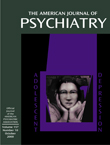Measuring Dopamine D2 Receptors
To the Editor: Nora D. Volkow, M.D., et al. (1) used [11C]raclopride and positron emission tomography (PET) to show differences in the striatal dopamine system between subjects who rated the effects of intravenous methylphenidate as pleasant and subjects who rated the effects as unpleasant. They concluded that the subjects in the first group had fewer striatal dopamine 2 (D2) receptors and that this may be a predisposing factor to drug addiction. However, the method they used does not measure D2 receptor density.
It has been shown by their group (2) and others (3–5) that the binding of [11C]raclopride depends on the level of endogenous dopamine present at the time of the scan. They incorrectly stated that the [11C]raclopride distribution volume (sometimes also referred to as binding potential) equals Bmax/KD, the ratio of total D2 receptor density to the dissociation constant of radiotracer and receptor. In fact, the distribution volume, as they calculated it, is more properly expressed as 
where Nf is the concentration of free dopamine and Kd/D is the affinity of dopamine for the D2 receptor (6).
This does not invalidate their result; however, the conclusion can only be that they showed a difference in the striatal dopamine system between the two groups of individuals, rather than a difference in dopamine receptor density. The former is a somewhat weak conclusion, as it does not necessarily imply an intrinsic or inherited difference in dopamine receptor numbers.
The brain is never in a “baseline” state, and a PET scan is a measure of the neurometabolic response to the experience of undergoing a PET scan, which may include varying degrees of anxiety and discomfort in different individuals. For example, one could imagine that subjects who are more anxious than others have a greater release of dopamine during PET scanning, which would affect the [11C]raclopride distribution volume. In short, it is not possible to measure D2 receptor density with [11C]raclopride with a single PET scan, although it can be done by using two scans with injections of radiotracer at different specific activity levels (7). Therefore, the theory that D2 receptor density is related to the risk of addiction is not supported by this PET study.
1. Volkow ND, Wang G-J, Fowler JS, Logan J, Gatley SJ, Gifford A, Hitzemann R, Ding YS, Pappas N: Prediction of reinforcing responses to psychostimulants in humans by brain dopamine D2 levels. Am J Psychiatry 1999; 156:1440–1443Google Scholar
2. Smith GS, Dewey SL, Brodie JD, Logan J, Vitkun SA, Simkowitz P, Schloesser R, Alexoff DA, Hurley A, Cooper T, Volkow ND: Serotonergic modulation of dopamine measured with [11C]raclopride and PET in normal human subjects. Am J Psychiatry 1997; 154:490–496Link, Google Scholar
3. Carson RE, Breier A, de Bartolomeis A, Saunders RC, Su TP, Schmall B, Der MG, Pickar D, Eckelman WC: Quantification of amphetamine-induced changes in [11C]raclopride binding with continuous infusion. J Cereb Blood Flow Metab 1997; 17:437–447Crossref, Medline, Google Scholar
4. Koepp MJ, Gunn RN, Lawrence AD, Cunningham VJ, Dagher A, Jones T, Brooks DJ, Bench CJ, Grasby PM: Evidence for striatal dopamine release during a video game. Nature 1998; 393:266–268Crossref, Medline, Google Scholar
5. Dewey SL, Smith GS, Logan J, Brodie JD, Fowler JS, Wolf AP: Striatal binding of the PET ligand 11C-raclopride is altered by drugs that modify synaptic dopamine levels. Synapse 1993; 13:350–356Crossref, Medline, Google Scholar
6. Endres CJ, Carson RE: Assessment of dynamic neurotransmitter changes with bolus or infusion delivery of neuroreceptor ligands. J Cereb Blood Flow Metab 1998; 18:1196–1210Google Scholar
7. Farde L, Eriksson L, Blomquist G, Halldin C: Kinetic analysis of central [11C]raclopride binding to D2-dopamine receptors studied by PET: a comparison to the equilibrium analysis. J Cereb Blood Flow Metab 1989; 9:696–708Crossref, Medline, Google Scholar



